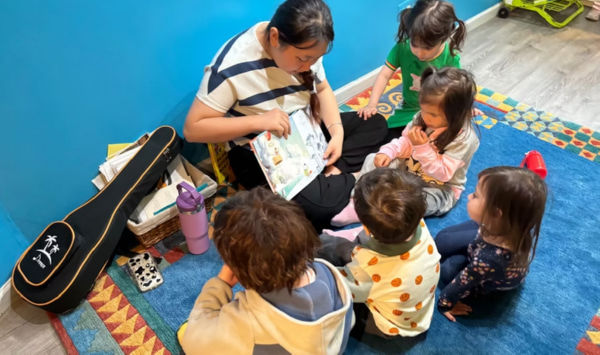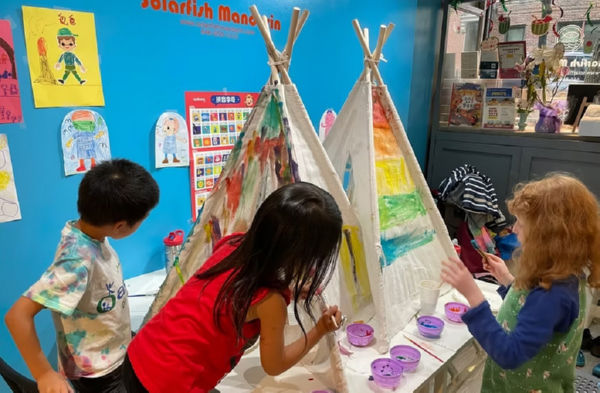Fun Mandarin for Beginners: 5 Effective Tips for Kids
- haikebaichuang
- Sep 8
- 5 min read
Say Goodbye to Boring Drills! 5 Fun Ways to Ignite Your Child's Love for Mandarin
As a parent, you know that forcing a child to sit and memorize flashcards is often a losing battle. The key question is, how to make learning fun? For young beginners, the journey into a new language should feel like an exciting adventure, not a chore. If you want to learn Mandarin for beginners in a way that truly sticks, the secret is to weave it into activities your child already loves. This guide will share five simple, effective, and incredibly fun mandarin lessons you can try at home today to spark genuine curiosity. Ready to transform learning into playtime? See how we make every day fun at Solarfish Mandarin.
1. Sing and Dance with Mandarin Songs and Rhymes
Music is a universal language, and for kids, it's a powerful tool for learning. Catchy melodies and simple, repetitive lyrics make mandarin songs one of the best ways to build vocabulary and master tones without even realizing it.

Why Music is a Powerful Tool for Language Memory
Rhythm and melody help cement new words and phrases in a child's brain, dramatically improving language memory. The tones of Mandarin, often a challenge for beginners, can be learned more naturally through the rise and fall of a tune.
Our Favorite Mandarin Nursery Rhymes for Beginners
Start with classics like "Liǎng Zhī Lǎohǔ" (Two Tigers) or "Zǎo Shàng Hǎo" (Good Morning). You can find countless animated versions online that add a visual element to the learning.
How to Turn Song Time into a Fun Mandarin Lesson
Don't just listen—participate! Create simple hand gestures or a dance for key words. Ask your child to point to their eyes, nose, or ears when they hear them in a song. This active engagement turns passive listening into an immersive lesson.
2. Explore New Worlds with Chinese Picture Books
Reading together is a cherished bonding activity, and it's a fantastic gateway to kids chinese learning. Chinese picture books offer a rich, visual context that helps children connect characters and words with their meanings.

Choosing the Right Books for Kids' Chinese Learning
Look for books with beautiful illustrations, simple and repetitive text, and themes your child loves, whether it's animals, adventures, or family. Pinyin (the romanized version of Mandarin) can be helpful, but don't shy away from character-only books where the pictures tell the story.
Interactive Reading: Making Stories Come Alive
Make interactive reading a performance! Use different voices for the characters. Pause and ask your child, "What do you think will happen next?" Have them point to objects in the illustrations as you name them in Mandarin.
3. Play Your Way to Fluency with Fun Mandarin Lessons
Children learn best through play. By transforming language practice into language games, you can eliminate pressure and maximize enjoyment. This is a cornerstone of effective mandarin for kids.

Simple Language Games to Play at Home (No Prep Needed!)
Try a game of "I Spy" in Mandarin ("Wǒ kàn dào...") or a scavenger hunt where you ask your child to find objects of a certain color ("zhǎo hóng sè de dōngxi"). Even a simple game of Simon Says ("Simon shuō...") can reinforce vocabulary for actions and body parts.
The Power of Role-Playing in Everyday Situations
Use role-playing during daily routines. Pretend to be at a restaurant and have your child order food in Mandarin, or act out buying groceries. This connects the language to real-world scenarios, making it practical and memorable.
4. Make Screen Time Count with Quality Apps and Cartoons
In today's world, screen time is a reality. The key is to make it productive. There are excellent resources that can supplement your child's learning journey in an entertaining way.
What to Look for in a Mandarin Learning App
A good learning app for kids should be game-based, visually engaging, and offer interactive feedback. Look for apps that focus on listening and speaking skills, not just character recognition.
Kid-Approved Chinese Cartoons That Actually Teach
Find cartoons made for native-speaking children, like "Peppa Pig" dubbed in Mandarin. The simple language and visual cues make it easy for beginners to follow along and absorb new vocabulary naturally.
5. Experience the Culture with Hands-On Activities
Language and culture are deeply intertwined. Engaging in hands-on activities makes the learning experience richer and more meaningful. It helps children understand that they are learning about a vibrant, living culture.
Simple Chinese Cooking Projects for Little Chefs
Making simple dishes like dumplings (jiǎozi) or sweet rice balls (tāngyuán) together is a delicious way to learn. You can practice vocabulary for ingredients and cooking actions.
Celebrating Festivals: Crafts for Chinese New Year
Get creative with cultural crafts! Make red paper lanterns or try some simple paper cutting for Chinese New Year. These activities provide a natural opportunity to talk about traditions and associated vocabulary.

Fostering a Lifelong Love for Learning Mandarin
The goal of these activities isn't to create a fluent speaker overnight. It's to spark curiosity, build positive associations, and foster a lifelong love for the language. By making the process joyful and engaging, you are giving your child a gift that will continue to grow long after the games are over.
Once you've ignited that initial spark, a structured, supportive, and equally fun environment can help it flourish into true proficiency. Discover the beginner programs at Solarfish Mandarin, where we turn this playful discovery into lasting skills.
Your Questions About Fun Mandarin Learning Answered
How can I help my child learn if I don't speak Mandarin? You absolutely can! Your role is to be an enthusiastic facilitator. Use online videos for pronunciation, learn alongside your child, and focus on the fun of the activity. Your positive attitude is the most important ingredient.
How much time should we dedicate to these activities each day? Consistency is more important than duration. Even 10-15 minutes of focused, fun activity each day can be more effective than a long, draining session once a week. Follow your child's lead and keep it light.
At what age can my child start with these fun lessons? It's never too early to start! Activities like singing songs and reading picture books can be introduced to toddlers. As they grow, you can introduce more complex games and crafts.
When is the right time to join a formal class? When you notice your child's curiosity growing and they start asking for more, that's a perfect sign. A formal class can provide the structure and social interaction to take their interest to the next level. If you've reached that point, we encourage you to explore the next steps with us.




Comments